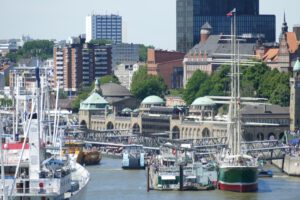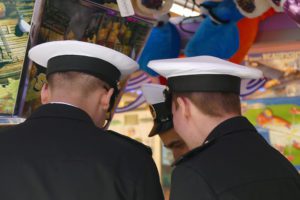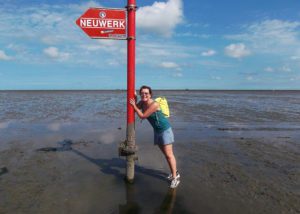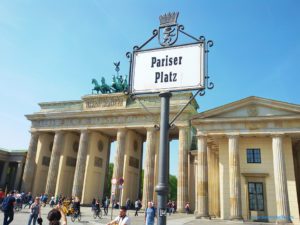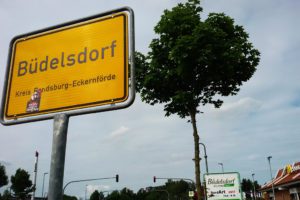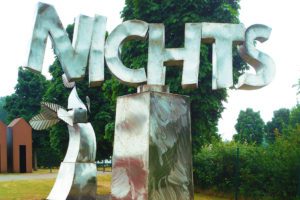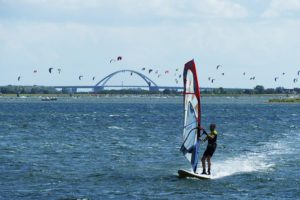Not only is the Baroque city of Dresden amazingly beautiful, but it is also nestled in a captivating landscape dotted with natural wonders, idyllic towns, and fairytale castles that are just second to none. Therefore, when visiting Dresden, you should better plan a few extra days to allow for at least one day trip, for example, to the Baroque Moritzburg Castle, the former hunting residence of the Electors and Kings of Saxony.

I was so looking forward to my trip to Moritzburg Castle! Seeing the majestic building reflected in the sun in the small lake, and the rays catching in the windows. And also to long walks to the Pheasant Castle and the lighthouse. It was supposed to be a day straight out of a fairytale.

And then the weather threw a wrench into my plans: gray clouds and an unpleasant drizzle were my travel companions.
Where there’s no sun, there’s no reflection.
Well, I guess even a fairytale castle has to face reality every now and then.
And so do its visitors.
Let’s make the best of it, because although the drizzle literally overshadows the glory, it cannot spoil the magnificence of Moritzburg.
Moritzburg Castle
Despite the unfortunate weather conditions, Moritzburg Castle is by far the most fairytale-like chateau I have ever seen. It was originally only the former hunting residence of the Electors and Kings of Saxony.

The Baroque four-wing complex was begun in 1542 under Duke Moritz in the Renaissance style. Even the hunting lodge at that time consisted of four thick round towers connected by a surrounding defensive wall. The building stands on an artificial island in the castle pond.

The ensemble also includes a beautiful castle park and the Pheasant Palace. The castle chapel was completed in 1672 under Elector John George II. However, it wasn’t until 1672 that the hunting lodge was expanded into a castle.
Augustus Takes Over
In 1697, Elector Augustus the Strong converted to Catholicism and became King of Poland. This resulted in the need for a Catholic place of worship. Augustus chose Moritzburg, obviously. The Protestant castle chapel was consecrated on Christmas Day 1699. Since then, Catholic services have been held in the palace chapel to this day!

In 1730, Augustus the Strong completed the palace’s Baroque reconstruction. Ponds and animal enclosures were also created in the surrounding area.
Their original functions give the palace’s four towers their names. The northeastern kitchen tower formerly served to supply the dining room, while the northwestern baking tower housed the bakery, obviously. To the southeast lies the Office Tower, and to the southwest the so-called Jägerturm, hence, the Hunter’s Tower.
Come On In
The interior was divided into twelve residential quarters with a total of 200 rooms. It accommodated the royal electoral family, their guests, as well as the servants. The first floor houses the four large state rooms, each two stories high.

In the palace’s entrance hall, a collection of gala carriages greets the visitors today.
The palace building is furnished with Baroque interior decoration from the time of Augustus the Strong. There are state rooms with lacquer and ceremonial furniture, hunting weapons, and paintings.

Among the most valuable treasures are gilded leather wallpapers from the 18th century, which are still preserved in eleven rooms. In the so-called billiard room, the monumental paintings on leather show genre scenes, while scenes from the ancient myths surrounding the hunting goddess Diana are depicted in the so-called Monstrous Hall.
The Greatest Treasures
The furnishings of many rooms are dedicated to court hunting. The collection of red deer antlers is considered one of the most important in the world. The most impressive part of the trophy collection is displayed in the dining room, where many of the 71 red deer trophies are between 270 and 400 years old. Among them is the world’s heaviest red deer antlers, almost two meters wide and weighing 19.8 kilograms.

The Stone Hall houses a collection of reindeer and elk antlers. The trophy of an extinct giant deer is mounted above its western entrance. The Russian Tsar Peter the Great gifted this unique, over 10,000 years old find to Augustus the Strong.

In 1723, Augustus the Strong acquired a magnificent bed for the Japanese Palace, whose canopy and bed curtains were made of approximately one million feathers from peacock, guinea fowl, duck, and pheasant.


Its creator, the Frenchman Le Normand, employed an ingenious technique: the feathers were not glued or woven on, as was customary, but woven into the fabric as weft threads on a loom.
Nevertheless, shortly after the purchase, the Elector had the bed curtains removed and converted into wall hangings. This is why the room was later called the Feather Room.
It is certainly not surprising that this incredibly beautiful castle has been the backdrop for several fairytale films.
Forests And Parks
The harmonious integration of the palace into the landscape is completed by the gardens to the north, the Pheasant Palace, located about two kilometers east and connected by a direct line of sight, with its small harbor and the Venus Fountain, and the Dardanelles.

The Friedewald forest to the north is traversed by an eight-pointed, star-shaped system of hunting lanes for par force hunting. At the intersection of these lanes, on a raised area in a forest clearing, lies the ruins of the Hellhaus, built in 1787. From here, the court society was supported in par force hunting, with a guard on the roof of the building indicating the direction of flight of the game using flags.
Pheasant Castle
The Pheasant Castle is located about two kilometers west of the Baroque palace. This extraordinary Rococo building is not only the smallest royal palace in Saxony, but also one of the most charming gems of courtly architecture. It was built in the 18th century as a charming retreat within the former pheasantry complex on behalf of the Saxon Elector Frederick Augustus III. Architecturally, the small palace is an artfully staged work of art that combines both Baroque and early Neoclassical elements.

Several rooms are spread across just 180 square meters, including a living and work room, bedrooms and toilets, and a ballroom on the upper floor. The furnishings are absolutely magnificent, with exotic wall coverings made of feathers, pearls, straw, and Chinese-style silk fabrics.
A special eye-catcher is the mandarin figure with a parasol on the roof, which sways in the wind.
The ensemble also includes the Baroque Venus Fountain, a small harbor basin with a pier, artificial islands, and a picturesque lighthouse. The lighthouse was built around 1780 as part of an open-air theater and was never used as a signaling device. Yet, it is one of the oldest inland lighthouses in Germany.
Plan Your Visit
From March to November, the palace is open daily from 10 a.m. to 6 p.m., and from November to March, it is open from 9:30 a.m. to 5:30 p.m. The admission of 12 €uros includes use of the amazing HistoPad.

I’ve introduced this clever gadget already in my post on Avignon, where it guided me through the Palace of the Popes.
Not only can the HistoPad be set to around a dozen languages, but it most importantly makes history exciting and tangible.
From May to November, the Pheasant Castle can also be visited for an additional 8 €uros, however, only on guided tours. These are available from Thursday to Sunday at 10:30 a.m., 12 p.m., 2 p.m., and 3:30 p.m. Advanced reservation on their website is therefore highly recommended.
How to Get There…
There are several options for getting from Dresden to Moritzburg by public transport. The most convenient and fastest is bus 477 from Dresden-Neustadt train station directly to Moritzburg. The bus usually runs hourly on weekdays and every two hours on weekends and holidays. The journey takes about 25 minutes.
Alternatively, you can choose a slightly longer, but scenic and historically attractive, route. To do this, first take the S1 S-Bahn line from Dresden Central Station towards Meissen and get off at Radebeul Ost. From there, the traditional Loessnitz Base Railway, a steam-powered narrow-gauge train, takes you to Moritzburg. This takes about 45 minutes, but it is worth it if you have enough time. From the Moritzburg train station, it’s about a 20-minute walk to the castle.

During the summer months from April to October, the excursion bus M runs five times a day between Meissen and Moritzburg Castle. If you’re coming from Dresden, you’ll first need to take the S1 to Meissen and then change to the bus.
…And How to Get Around
Moritzburg isn’t very large. It’s only about two kilometers from the train station to the castle, and you can always take bus #477 or #458 if you’re tired of walking
The castle grounds, the game reserve, the Pheasant Castle, and the lighthouse are easily accessible on foot.
Cycling is also a valid option, obviously. Well-signposted cycle routes lead to the important sights and around the ponds.

You can rent a bike from the Moritzburg Information Center at Schlossallee 3b. Advance reservation is recommended, of course. They charge 8 €uros for half a day and 10 €uros for a full day. Keep in mind that you also have to pay a deposit of 50 €uros.
An alternative is the app-based bike-sharing service MietOn. Stations can be found, for example, at the Moritzburg Castle parking lot and at the Moritzburg train station. One hour costs 2.50 €uros and an entire day 15 €uros. Obviously, the App always charges the cheapest rate.
Maps as well as tour suggestions are available at the Moritzburg Information Center and the train station.
Visiting Organized
I’m an avid solo-travelling woman, yet I love to join organized tours here and there. Especially for day and weekend trips to cities, organized and guided tours allow you to get to know the most important sights in a condensed yet comprehensive way and not miss the best.

Therefore, here are some great tours from Dresden to Moritzburg. Especially if you have only a short amount of time, they’ll enable you to leave the planning and organizing to others and just enjoy the excursion to the max*:
Pinnable Pictures
If you choose to pin this post for later, please use one of these pictures:



Did You Enjoy This Post? Then You Might Also Like These:
24 hours in HAMBURG
Guide to HAMBURG, the self-proclaimed Gateway to the World
Baroque Splendor And River Romance: The Must-Sees of DRESDEN
The Island of NEUWERK – where the way is the goal
BERLIN guide: get the most for less on bus 100
We’ll Always Have Büdelsdorf – bye:myself at the NordArt 2017
Büdelsdorf Revisited – bye:myself at the NordArt 2018
A VAN-TASTIC TRIP to the ISLAND of FEHMARN
Disclaimer: This post was created with the generous support of Dresden Marketing GmbH. They put together an inspiring program for me and covered all my expenses. However, all opinions regarding the services are my own and were in no way influenced by my cooperation partner.
* This is an affiliate link. Hence, if you book through this page, not only do you get the best deal. I also get a small commission that helps me run this blog. Thank you so much for supporting me!
